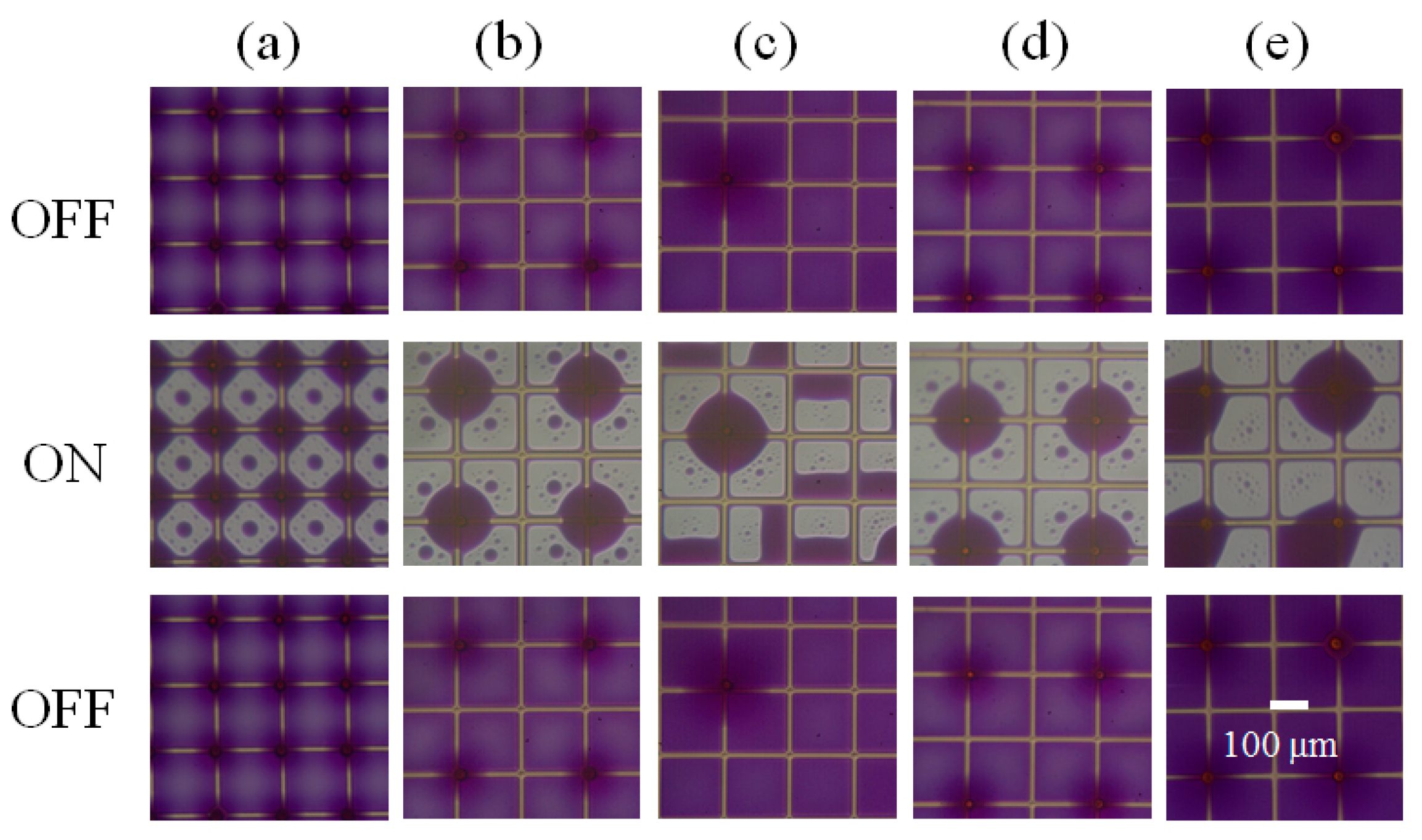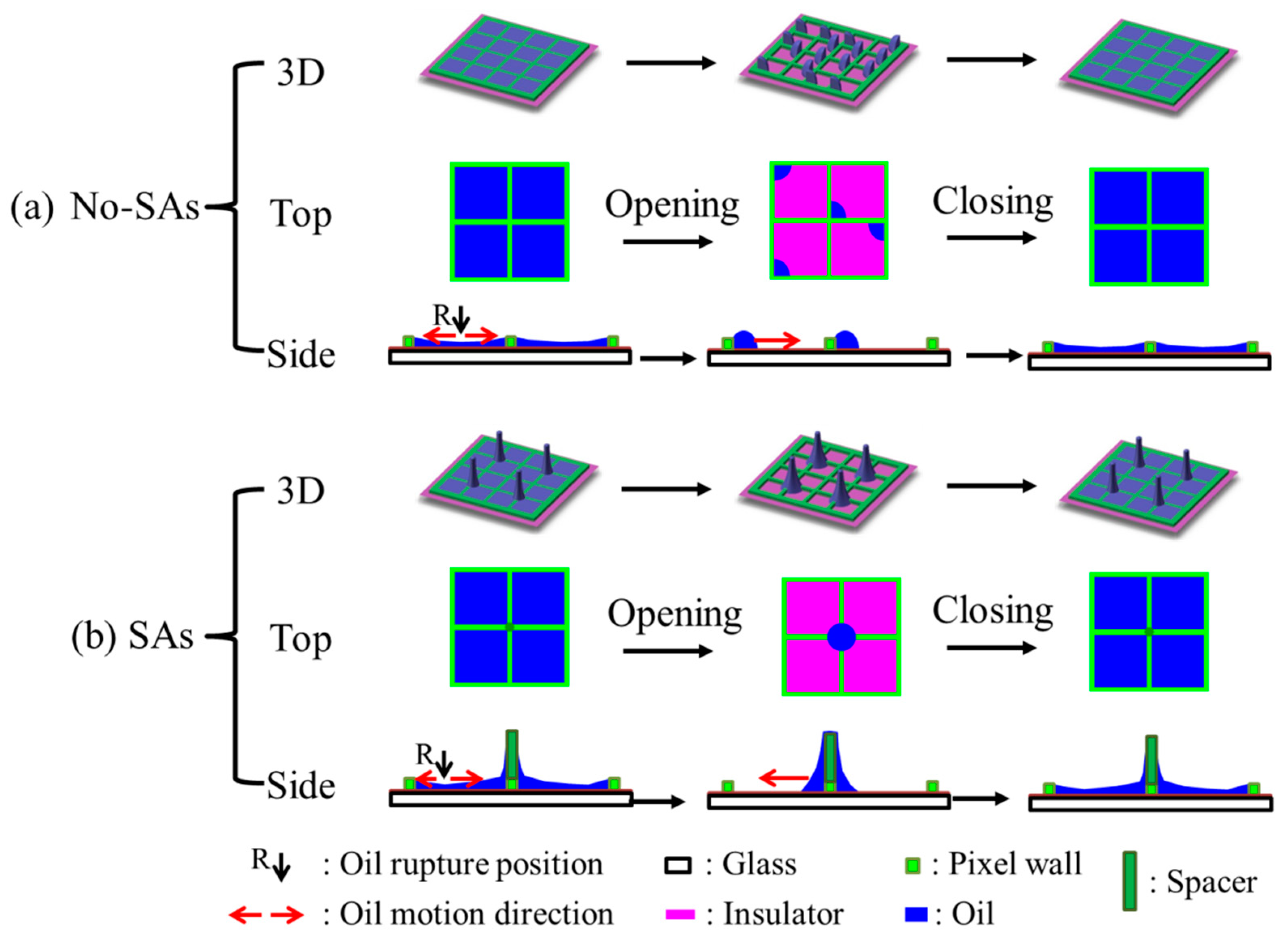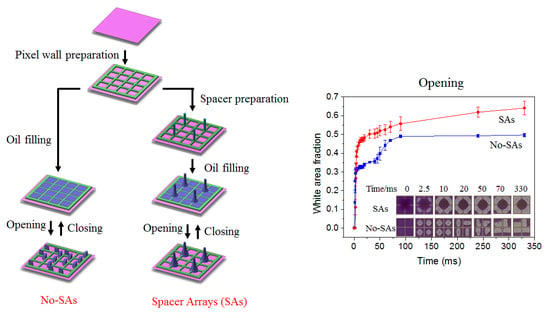Photolithography Fabricated Spacer Arrays Offering Mechanical Strengthening and Oil Motion Control in Electrowetting Displays
Abstract
:1. Introduction
2. Experimental Section
2.1. Chemicals and Materials
2.2. EWD Fabrication
2.3. Wettability Characterization
2.4. Mechanical Strength Measurement
2.5. Switching Behavior of Electrowetting Display
3. Results and Discussion
3.1. Fabrication of Spacer Arrays
3.2. Mechanical Strength Enhancement by Spacer Arrays
3.3. Oil Motion Control of Spacer Arrays
3.3.1. Spacer Density and Height
3.3.2. Applied Voltage
3.3.3. Optical Performance of EWD with and without Spacer Arrays
4. Conclusions
Supplementary Materials
Author Contributions
Funding
Acknowledgments
Conflicts of Interest
References
- Shui, L.; Hayes, R.A.; Jin, M.; Zhang, X.; Bai, P.; van den Berg, A.; Zhou, G. Microfluidics for electronic paper-like displays. Lab Chip 2014, 14, 2374–2384. [Google Scholar] [CrossRef] [PubMed]
- Bai, P.F.; Hayes, R.A.; Jin, M.; Shui, L.; Yi, Z.C.; Wang, L.; Zhang, X.; Zhou, G. Review of paper-like display technologies (invited review). Prog. Electromagn. Res. 2014, 147, 95–116. [Google Scholar] [CrossRef] [Green Version]
- Heikenfeld, J.; Drzaic, P.; Yeo, J.-S.; Koch, T. Review Paper: A critical review of the present and future prospects for electronic paper. J. Soc. Inf. Display 2011, 19, 129–156. [Google Scholar] [CrossRef] [Green Version]
- Hayes, R.A.; Feenstra, B.J. Video-speed electronic paper based on electrowetting. Nature 2003, 425, 383–385. [Google Scholar] [CrossRef]
- Seyrat, E.; Hayes, R.A. Amorphous fluoropolymers as insulators for reversible low-voltage electrowetting. J. Appl. Phys. 2001, 90, 1383–1386. [Google Scholar] [CrossRef]
- Zhang, X.M.; Bai, P.F.; Hayes, R.A.; Shui, L.L.; Jin, M.L.; Tang, B.; Zhou, G.F. Novel driving methods for manipulating oil motion in electrofluidic display pixels. J. Disp. Technol. 2016, 12, 200–205. [Google Scholar] [CrossRef]
- Zhou, M.; Zhao, Q.; Tang, B.; Groenewold, J.; Hayes, R.A.; Zhou, G. Simplified dynamical model for optical response of electrofluidic displays. Displays 2017, 49, 26–34. [Google Scholar] [CrossRef]
- Hsieh, W.-L.; Lin, C.-H.; Lo, K.-L.; Lee, K.-C.; Cheng, W.-Y.; Chen, K.-C. 3D electrohydrodynamic simulation of electrowetting displays. J. Micromech. Microeng. 2014, 24, 125024. [Google Scholar] [CrossRef]
- Mugele, F.; Baret, J.-C. Electrowetting: From basics to applications. J. Phys. Condens. Mat. 2005, 17, R705–R774. [Google Scholar] [CrossRef]
- Chen, L.; Xie, S.; Cao, J.; Yan, Z.; Jiang, H.; Dou, Y.; Deng, Y.; Zhou, G.; Jin, M.; Shui, L. Particle directed dual-fluid flow driven by electrowetting for controllable multiway light valves. Appl. Phys. Lett. 2018, 112, 233703. [Google Scholar] [CrossRef]
- He, T.; Jin, M.; Eijkel, J.C.T.; Zhou, G.; Shui, L. Two-phase microfluidics in electrowetting displays and its effect on optical performance. Biomicrofluidics 2016, 10, 011908. [Google Scholar] [CrossRef] [PubMed] [Green Version]
- You, H.; Steckl, A.J. Electrowetting on flexible substrates. J. Adhes. Sci. Technol. 2012, 26, 1931–1939. [Google Scholar] [CrossRef] [Green Version]
- Mugele, F. Fundamental challenges in electrowetting: From equilibrium shapes to contact angle saturation and drop dynamics. Soft Matter 2009, 5, 3377–3384. [Google Scholar] [CrossRef]
- Chen, L.; Tu, Y.; Wang, L.; Li, Q.; Yang, X.; Xia, J.; Feenstra, B.J.; Giraldo, A.; Rösler, N. Investigation of oil-motion non-uniformity in a reflective display based on electrowetting. J. Soc. Inf. Display 2010, 18, 113–120. [Google Scholar] [CrossRef]
- Li, X.T.; Bai, P.F.; Gao, J.W.; Zhou, G.F. Effect of pixel shape on fluid motion in an electrofluidic display. Appl. Mech. Mater. 2014, 635–637, 1159–1164. [Google Scholar] [CrossRef]
- Dou, Y.; Tang, B.; Groenewold, J.; Li, F.; Yue, Q.; Zhou, R.; Li, H.; Shui, L.; Henzen, A.; Zhou, G. Oil motion control by an extra pinning structure in electro-fluidic display. Sensors 2018, 18, 1114. [Google Scholar] [CrossRef] [Green Version]
- Giraldo, A.; Vermeulen, P.; Figura, D.; Spreafico, M.; Meeusen, J.A.; Hampton, M.W.; Novoselov, P. 46.3: Improved oil motion control and hysteresis-free pixel switching of electrowetting displays. SID Symp. Dig. Tech. Pap. 2012, 43, 625–628. [Google Scholar] [CrossRef]
- Heikenfeld, J.; Steckl, A.J. Intense switchable fluorescence in light wave coupled electrowetting devices. Appl. Phys. Lett. 2005, 86, 011105. [Google Scholar] [CrossRef] [Green Version]
- Wang, M.; Guo, Y.; Hayes, R.A.; Liu, D.; Broer, D.J.; Zhou, G. Forming spacers in situ by photolithography to mechanically stabilize electrofluidic-based switchable optical elements. Materials 2016, 9, 250. [Google Scholar] [CrossRef]
- Convert, L.; Chabot, V.; Zermatten, P.-J.; Hamel, R.; Cloarec, J.-P.; Lecomte, R.; Aimez, V.; Charette, P.G. Passivation of KMPR microfluidic channels with bovine serum albumin (BSA) for improved hemocompatibility characterized with metal-clad waveguides. Sens. Actuators B 2012, 173, 447–454. [Google Scholar] [CrossRef] [Green Version]
- Sharma, S.; Sharma, A.; Cho, Y.K.; Madou, M. Increased graphitization in electrospun single suspended carbon nanowires integrated with carbon-MEMS and carbon-NEMS platforms. ACS Appl. Mater. Interfaces 2012, 4, 34–39. [Google Scholar] [CrossRef]
- Shirtcliffe, N.J.; Aqil, S.; Evans, C.; McHale, G.; Newton, M.I.; Perry, C.C.; Roach, P. The use of high aspect ratio photoresist (SU-8) for super-hydrophobic pattern prototyping. J. Micromech. Microeng. 2004, 14, 1384–1389. [Google Scholar] [CrossRef] [Green Version]
- Campo, A.D.; Greiner, C. SU-8: A photoresist for high-aspect-ratio and 3D submicron lithography. J. Micromech. Microeng. 2007, 17, R81–R95. [Google Scholar] [CrossRef] [Green Version]
- Chen, X.; He, T.; Jiang, H.; Wei, B.; Chen, G.; Fang, X.; Jin, M.; Hayes, R.A.; Zhou, G.; Shui, L. Screen-printing fabrication of electrowetting displays based on poly (imide siloxane) and polyimide. Displays 2015, 37, 79–85. [Google Scholar] [CrossRef]
- Cardoso, V.; Dias, O.J. Rayleigh-Plateau and Gregory-Laflamme instabilities of black strings. Phys. Rev. Lett. 2006, 96, 181601. [Google Scholar] [CrossRef] [PubMed] [Green Version]






© 2020 by the authors. Licensee MDPI, Basel, Switzerland. This article is an open access article distributed under the terms and conditions of the Creative Commons Attribution (CC BY) license (http://creativecommons.org/licenses/by/4.0/).
Share and Cite
Dou, Y.; Chen, L.; Li, H.; Tang, B.; Henzen, A.; Zhou, G. Photolithography Fabricated Spacer Arrays Offering Mechanical Strengthening and Oil Motion Control in Electrowetting Displays. Sensors 2020, 20, 494. https://doi.org/10.3390/s20020494
Dou Y, Chen L, Li H, Tang B, Henzen A, Zhou G. Photolithography Fabricated Spacer Arrays Offering Mechanical Strengthening and Oil Motion Control in Electrowetting Displays. Sensors. 2020; 20(2):494. https://doi.org/10.3390/s20020494
Chicago/Turabian StyleDou, Yingying, Lin Chen, Hui Li, Biao Tang, Alex Henzen, and Guofu Zhou. 2020. "Photolithography Fabricated Spacer Arrays Offering Mechanical Strengthening and Oil Motion Control in Electrowetting Displays" Sensors 20, no. 2: 494. https://doi.org/10.3390/s20020494





